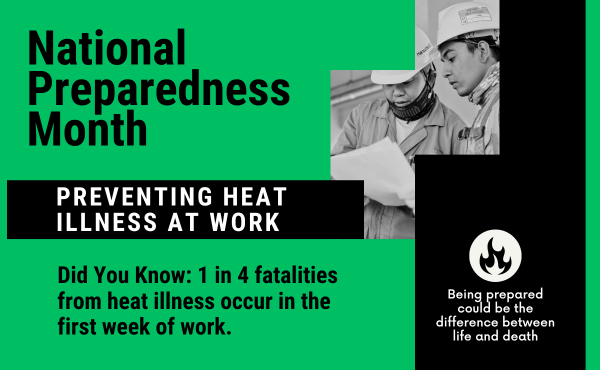
September is National Preparedness Month, an observation with the goal of raising awareness about the importance of preparing for disasters or emergencies that could occur at any given time. Understanding how to prepare for, react to, and respond to emergencies is an important safety skillset to have as we deal with emergencies each and every day. Most of us are taught in school how to react to tornados and earthquakes, however there are many other areas that can pose a threat to us that we often aren’t taught about or know the importance of. One such area is heat illness, a condition caused by strenuously working in the heat.
What is Heat Illness?
Heat illness is defined as “a serious medical condition resulting from the body’s inability to cope with a particular heat load, and includes heat cramps, heat exhaustion, heat syncope, and heat stroke” from the California Code of Regulations Title 8 Section 3395. As we overheat, our bodies naturally attempt to cool off by increasing blood flow to the outer layers of our skin with the hope that the heat can be released into the environment around us, however if the environment around us is warmer than the skin, we begin to sweat which helps cool our bodies. If we’re strenuously working in an environment warmer than our body, we will sweat about a quart of water each hour, and with more blood flowing to our outer layer of skin, our brain, muscles, and organs are receiving less blood which results in conditions such as fatigue, dehydration, muscle cramps, weakness, and confusion. If we continue to work in these conditions, our bodies will be unable to keep our temperature within the range it needs to be and it could result in a heatstroke which damages our vital organs and can be fatal.
How to Prevent Heat Illness
There are several ways you can prepare and prevent heat illness when work requires you to be exposed to high temperatures. First of all, if it’s the first time in a while you’re exposed to high temperatures, it’s important to ease yourself into it. 1 in 4 fatalities from heat illness occur in the first week of working in these conditions. If it is your first week, you should follow the 20% rule: on the first day work no more than 20% of the shift’s duration at full intensity and keep adding 20% each day until your body is used to working in the heat. Constantly drink cold water, you should at least have 1 cup of water every 20 minutes. Take frequent rests and breaks, ensure your body is recovered from working in the heat before getting back to work. Ideally these breaks should be in shaded or cool locations, if the jobsite doesn’t have a location like this, consider bringing your own portable tent(s) to set up so workers can take breaks in the shade. Wear loose-fitting, breathable, and light-colored clothing as well as a hat, if possible, when working in the heat. Keep an eye on your coworkers, ask them a lot of questions on how they’re feeling, and check for signs of heat illness. If you’re wearing a face covering, be sure to change it out as it gets wet.
Common Signs of Heat Illness
Below are some common signs of heat illness that you can identify in yourself or your coworkers:

- Headache or nausea
- Weakness and dizziness
- Heavy sweating, or hot, dry skin
- Elevated body temperature
- Thirst
- Decreased urine output
How Can You Help:
Here are a few ways you can help each other out when working in the heat:
- Hand out cold water for everyone to drink
- Remove unnecessary clothing
- Move to or suggest to move to a cooler location
- Cool off with water, ice, or a fan
- Don’t leave anyone alone
- Seek medical care if needed
First Aid Steps for Heat Illness
If you notice one of your coworkers is behaving or thinking abnormally, has slurred speech, is seizing, or loses consciousness you need to perform first aid for them. You should immediately call 911 or have someone else call 911. Attempt to cool off the worker with water or ice and stay with them until help arrives.
Preparing for Working in the Heat
Heat illness is no joke, and if you know you’re going to have a job that requires you and your team to be exposed to the heat for long periods of time it’s important to prepare. Consider purchasing clothing for the job such as lightweight shirts and cooling vests, cooling arm sleeves, hydration packs, and hats. Bring coolers, fans, sunscreen, and water bottles to the jobsite. Consider bringing portable work shelters and tents to jobsites that can provide shade when workers are taking breaks. Come up with a schedule that ensures workers are taking enough breaks and getting enough water, and finally, keep an eye out on other workers. Check in with them frequently to see how they’re doing or if they’re behaving differently in any way. Below are some resources that can help you be prepared for working in the heat.
You can shop for ergodyne workplace safety products by clicking here.
As always, if you have any questions about how you can better prepare for working in the heat, reach out to us at any time and we’ll be happy to help.
Sources: National Preparedness Month | California Department of Industrial Relations
